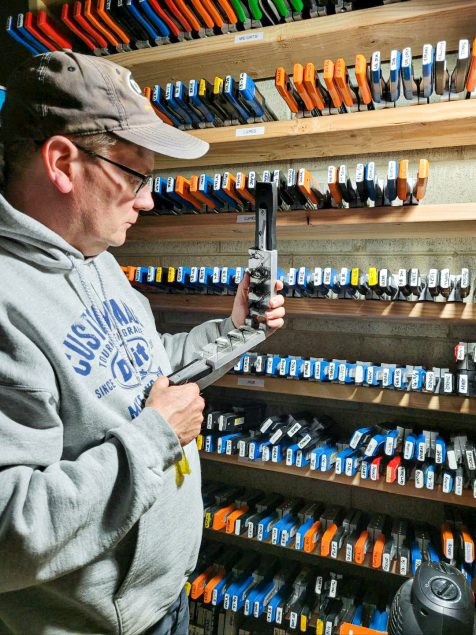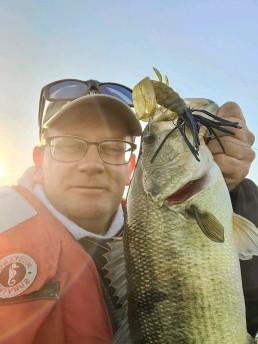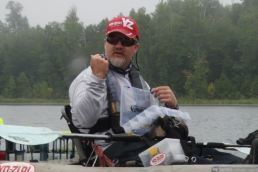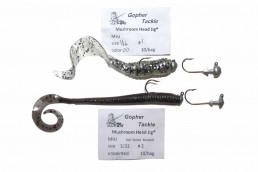Why We Do-it
SHARE THIS POST
It was about a million years ago (well, maybe 45) when a high school fishin’ buddy of mine brought in some chenille crappie jigs for me to look at. They were awesome—like nothing I had ever seen before—with two-toned heads and bodies and a little sparkle added into the tail. Crappie jigs were sort of a catch-anything lure for us back then, but the selection at the tackle shop was black, white, pink or yellow…(yawn). These were so cool, and I needed to know who had them. He said, “I made them.” “You made them? How?” I replied.
The next day, he lent me his supplies and tying vise, and gave me a little instruction at the end of our drafting class. And…the proverbial… “The rest is history.”
I was very fortunate to live in the Milwaukee area and have access to one of the best lure-building stores in the Midwest. Reinke Brothers was one of the largest Do-it Mold dealers in the country at the time, and under the guidance of the late Bob Reinke, this innocent introduction to tying a crappie jig became a lifelong passion.
Making lures started out as a creative outlet for my fishing obsession. I am only a casual fly fisherman, but I always admired fly tyers and their ability to create something out of feathers, hair and fur and turn it into something that looked alive in the water; something so alive that a fish would mistake it for a living item that they would want to eat.
Tying jigs with the inspiration from the color plates in old fly fishing books were my first attempts, and I found out quite quickly that a Leftys Deceiver or White Whistler tied on a 3/8-ounce round jig head was a killer on Lake Michigan trout and salmon. A woolly bugger tied on a 1/8- or 1/4-ounce jig head was a deadly largemouth and smallmouth lure.
I could ramble on and on about where this journey has taken me over the last 45 years, but in general, if I am not fishing, I am making lures and building a new creation for the next trip—whether it’s in a week, or the next day. My tackle cave is where I disconnect from the daily grind and don’t think about anything else except fooling fish!
I want to first dispel any notions that you need to be an artist or a great lure maker like Jim Bagley, Lauri Rapala, Lee Sisson or Gary Yamamoto to be able to create your own lures. The tools from Do-it molds in the form of jig molds, soft plastic molds, paints and finishes, self-stick eyes and a huge variety of hooks will immediately take you from beginner to high-quality lure maker. Lures can be as pretty or as “functional” as you want to make them. And I will tell you from experience, a “functional” lure will catch just as many fish as the pretty ones, so don’t worry about being perfect. But it is kinda’ fun to show off occasionally when you have time to really “create.”
Making your own lures can be extremely cost effective if you are an avid angler. A simple bucktail jig from the tackle shop can be anywhere $3.50 to almost $8.00 these days. That same jig can be made in your own tackle shop for about $.50, and that includes a hook that is probably better than the store-bought ones.
Spinnerbaits and bladed jigs are another huge savings item for home crafters. On average, you can make these two for about 25 to 30 percent of the cost of one off the store shelf. Not only that, but you are also quality control, and you have the final decision on the quality of the components in your creation.

Are you enjoying this post?
You can be among the first to get the latest info on where to go, what to use and how to use it!
The ability to create the perfect lure has made a huge difference in the author’s angling success.
Back when my niece and nephew were bass fishing with me on summer vacations, we discovered the effectiveness of the Yamamoto Senko worm. The fishing was great, but at the end of the week, we could go through ten to twelve bags of Senko worms. At $7 a bag, that added up quickly. Do-it actually has an agreement with Gary Yamamoto to make a mold that makes an exact replica of a Senko worm. Now you can make them any time you need them, in any color you please, for a fraction of the price. The same holds true for many of the common plastics used for bass, pike, walleyes and crappies. Do-it now has hundreds of molds to suit any fishing needs.
There are many good reasons to make your own lures, but for me, the number one reason is performance. Being able to make exactly what I need for particular fishing situations is important to my fishing success. I could never be handcuffed by what is on the tackle shop walls anymore. It’s all about the perfect weight, the perfect shape and balance, and getting the perfect color and size. When you put it all together and it works, it’s so much more than catching a fish. Its fooling a fish on something that you made from scratch.
I still think about those first jigs crappie jigs I tied, casting them at the local quarry and catching bass on them. It wasn’t just fishing anymore. It was a full circle of angling education. It was thinking about how heavy that jig should be. It was about what color it should be and what it represented. Should it match the baitfish… or maybe not? Could I make it weedless or snag-proof? Will it need to swim freely like a baitfish, or bounce on the bottom like a crawfish? When I wasn’t fishing, I was thinking, planning and making a lure or lures for the next trip. Making my own lures has added so much to my enjoyment of the sport.
Do-it molds has everything you need to dip your toe into lure making, or dive in headfirst. Not only all the supplies, but tutorial videos taking you step-by-step through all the processes, from pouring jigs or lead baits to pouring plastics and painting lures—you name it. They have everything covered. Check it all out at www.store.do-itmolds.com.
Just remember that there is no greater satisfaction than catching a fish on a lure that you made yourself.
Marc Wisniewski is an avid Wisconsin angler specializing in Lake Michigan shore and inshore fishing. He also chases bass, pike, and muskies anywhere he can. He has built custom rods for 35 years and makes lures from wood, lead and soft plastics. Wisniewski has been writing fishing articles for more than 30 years.
MWO
SHARE THIS POST
Did you enjoy this post?
You can be among the first to get the latest info on where to go, what to use and how to use it!
Marc Wisniewski
Marc Wisniewski is an avid Wisconsin angler specializing in Lake Michigan shore and inshore fishing. He also chases bass, pike, and muskies anywhere he can. He has built custom rods for 35 years and makes lures from wood, lead and soft plastics. Wisniewski has been writing fishing articles for more than 30 years.



